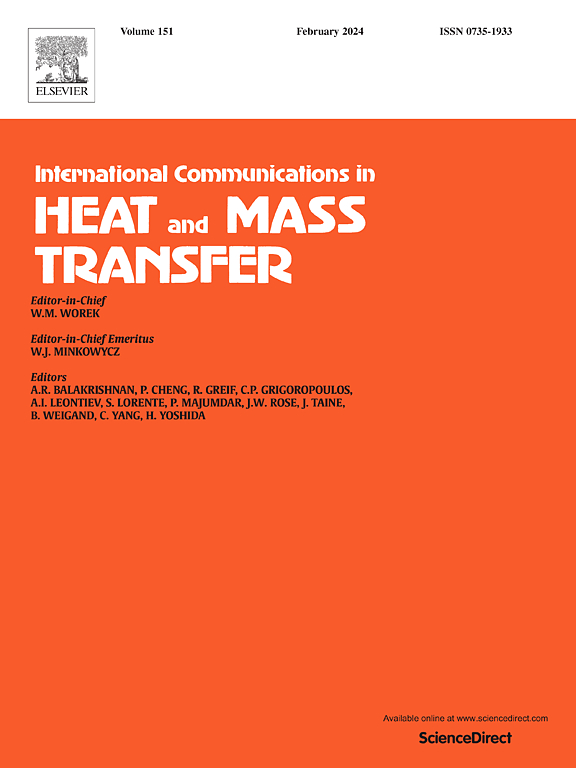A numerical investigation of droplet bouncing behaviors on dual micro-structured superhydrophobic surfaces
IF 6.4
2区 工程技术
Q1 MECHANICS
International Communications in Heat and Mass Transfer
Pub Date : 2025-07-18
DOI:10.1016/j.icheatmasstransfer.2025.109384
引用次数: 0
Abstract
An in-depth study of the droplet bouncing behavior and microscopic mechanism on superhydrophobic surfaces containing different micro-structures is of great significance in the power production and transmission fields. In this study, the lattice Boltzmann method with multiple relaxation times (LBM-MRT) was used to investigate the droplets bouncing process on superhydrophobic surfaces. Three groups of novel superhydrophobic surface microstructures were developed based on the protrusion/recess dimensions of columnar structures and the distribution positions of randomly rough microstructures. All randomly rough micro-structures were characterized by skewness (−1.1 to 1.1), kurtosis (1.0 to 5.0) and standard deviation (0.3 to 1.1). The basic morphology and roughness parameters of the randomly rough micro-structures were extracted using atomic force microscopy (AFM). In turn, the various types of surfaces required for numerical simulations were obtained by numerical reconstruction methods. Use liquid-gas density ratios of 800 and gas-liquid dynamic viscosity ratios of 10, which are extremely close to the corresponding parameters for air and water. After experimental validation, the droplet bouncing dynamics were compared and summarized. The maximum spreading length, total contact time and post-bounce morphology of the droplets during the bouncing process were analyzed. The results shown that column with a spacing of 30 μm was able to produce the maximum radial spreading tendency of the droplets. On the P-R-R surface, the increase in the columns spacing reduced the drop rate of total contact time from 9.04 % to 5.89 % and then increased to 7.35 %. Droplets bounced best on surfaces with relatively uniform overall morphology and relatively fewer excessive spikes and deep valleys. The specific parameter ranges satisfy skewness −0.5 to 0.3, kurtosis 3.0, and standard deviation 0.3 to 0.5. Based on data of droplets bouncing on typical surfaces, we also summarize empirical equations for the relationship between maximum spreading length and total contact time and skewness. The regularities obtained in this paper on the effect of dual micro-structures on the dynamic behavior of droplets may contribute to the in-depth optimization of superhydrophobic surfaces.
双微结构超疏水表面液滴弹跳行为的数值研究
深入研究液滴在不同微观结构的超疏水表面上的弹跳行为和微观机理,在电力生产和传输领域具有重要意义。本研究采用多重弛豫时间晶格玻尔兹曼方法(LBM-MRT)研究了液滴在超疏水表面的弹跳过程。基于柱状结构的突出/隐窝尺寸和随机粗糙微结构的分布位置,形成了三组新型超疏水表面微结构。所有随机粗糙微观结构的特征为偏度(- 1.1 ~ 1.1)、峰度(1.0 ~ 5.0)和标准差(0.3 ~ 1.1)。利用原子力显微镜(AFM)提取了随机粗糙微结构的基本形貌和粗糙度参数。然后,通过数值重建方法获得数值模拟所需的各种类型的曲面。采用气液密度比为800,气液动态粘度比为10,这与空气和水的相应参数极为接近。经过实验验证,对液滴的弹跳动力学进行了比较和总结。分析了弹跳过程中液滴的最大扩散长度、总接触时间和弹跳后形貌。结果表明,当柱间距为30 μm时,液滴径向扩散趋势最大;在P-R-R表面,随着柱间距的增大,总接触时间的下降率从9.04%下降到5.89%,再上升到7.35%。液滴在整体形态相对均匀、过多尖峰和深谷相对较少的表面上反弹得最好。具体参数范围满足偏度- 0.5 ~ 0.3、峰度3.0、标准差0.3 ~ 0.5。根据液滴在典型表面上的弹跳数据,我们还总结了最大扩散长度与总接触时间和偏度之间关系的经验方程。本文所获得的双微观结构对液滴动力学行为影响的规律可能有助于超疏水表面的深入优化。
本文章由计算机程序翻译,如有差异,请以英文原文为准。
求助全文
约1分钟内获得全文
求助全文
来源期刊
CiteScore
11.00
自引率
10.00%
发文量
648
审稿时长
32 days
期刊介绍:
International Communications in Heat and Mass Transfer serves as a world forum for the rapid dissemination of new ideas, new measurement techniques, preliminary findings of ongoing investigations, discussions, and criticisms in the field of heat and mass transfer. Two types of manuscript will be considered for publication: communications (short reports of new work or discussions of work which has already been published) and summaries (abstracts of reports, theses or manuscripts which are too long for publication in full). Together with its companion publication, International Journal of Heat and Mass Transfer, with which it shares the same Board of Editors, this journal is read by research workers and engineers throughout the world.

 求助内容:
求助内容: 应助结果提醒方式:
应助结果提醒方式:


